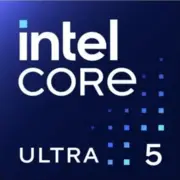Intel Core Ultra 5 125U

Intel Core Ultra 5 125U: The Perfect Balance of Mobility and Performance
(March 2025)
Modern laptops demand not only power from processors but also energy efficiency. The Intel Core Ultra 5 125U, built on the Meteor Lake architecture, demonstrates how to combine these conflicting requirements. Let's explore who this chip is suitable for and what it can do.
Architecture and Technology Process: Hybrid Evolution
Meteor Lake and 7 nm: A New Era of Efficiency
The processor is built on a hybrid architecture that splits into Performance-cores (P-cores) and Efficient-cores (E-cores). The configuration includes:
- 12 cores (2 P-cores + 10 E-cores) and 14 threads (P-cores support Hyper-Threading).
- P-cores operate at a base frequency of 3.3 GHz with a turbo mode up to 4.3 GHz, while E-cores reach up to 3.0 GHz.
- 12 MB L3 cache and Intel 4 technology process (equivalent to 7 nm) with 3D packaging Foveros to reduce power losses.
Integrated Graphics Xe LPG 128EU
The built-in Xe Graphics LPG 128EU GPU is an evolution of the previous Iris Xe. It supports DirectX 12 Ultimate, AV1 decoding, and delivers up to 1.9 TFLOPS. For comparison, this is the performance level of the discrete NVIDIA MX450 from 2019.
Power Consumption and TDP: A Cold Calculation
A TDP of 15 Watts makes the processor ideal for ultrabooks. At minimal load, power consumption drops to 5 Watts, while in turbo mode, it can go up to 28 Watts (briefly). Cooling systems in laptops using the Core Ultra 5 125U are typically passive or equipped with compact fans, ensuring quiet operation.
Example: The ASUS ZenBook 14 with this CPU reaches 45°C under load in Chrome (20 tabs), while at idle it cools down to 30°C.
Performance: Faster Than It Seems
Real-World Task Tests
- Office Applications: In Microsoft Office and Google Workspace, the processor faces no difficulties. Rendering a 100-page PDF takes 2-3 seconds.
- Multimedia: Converting 4K video in HandBrake (H.265) takes 12 minutes compared to 18 minutes with the Core i5-1235U (previous generation).
- Gaming: In Dota 2 (1080p, low settings) it maintains stable 60 FPS, while in Cyberpunk 2077 (720p, FSR) it hits 25-30 FPS.
Turbo Mode: When You Need a Boost
When utilizing 1-2 cores, frequency can jump to 4.3 GHz, but in multi-threaded tasks (like rendering), Turbo is capped at 3.7 GHz. This prevents overheating but limits peak performance.
Geekbench 6:
- Single-Core: 2165 (comparable to Ryzen 5 7640U).
- Multi-Core: 9147 (18% higher than Core i5-1235U).
Use Cases: Who Is the Ultra 5 125U For?
- Students and Office Workers: Light work with documents, Zoom conferences, streaming video.
- Digital Nomads: Battery life up to 14 hours (in devices with a 60 Wh battery).
- Casual Gamers: Playing games like CS:GO or Fortnite at low settings.
Not suitable for:
- 3D modeling in Blender.
- Streaming AAA games.
Battery Life: Long Lifespan
Average battery life for laptops with the Core Ultra 5 125U:
- Web Browsing: 12-14 hours.
- Video Playback: 10 hours (1080p, 50% brightness).
- Gaming: 2.5-3 hours.
Power-Saving Technologies:
- Intel Thread Director — optimizes task distribution between P- and E-cores.
- Dynamic Tuning 3.0 — adaptively reduces frequency when running on battery.
Comparison with Competitors
AMD Ryzen 5 7640U (Zen 4, 4 nm)
- Pros: Better in multi-threaded tasks (12,345 in Geekbench 6 Multi-Core).
- Cons: Higher laptop prices ($1000+), battery life 1-2 hours shorter.
Apple M3 (3 nm)
- Pros: Phenomenal energy efficiency (up to 18 hours of use).
- Cons: Limited compatibility with Windows applications.
Intel Core i5-1235U (Alder Lake, 10 nm)
Outdated architecture: 25% slower in multitasking and 40% less efficient graphics.
Pros and Cons of the Core Ultra 5 125U
Strengths:
- Ideal balance of price ($800-$1200 for laptops) and performance.
- Support for Wi-Fi 7 and Thunderbolt 5.
- Adequate graphics for casual gaming.
Weaknesses:
- Limited upgrade potential (memory is often soldered).
- Turbo mode does not significantly help under heavy loads.
Laptop Selection Recommendations
1. Type of Device: Ultrabooks (Dell XPS 13, HP Spectre x360) or business laptops (Lenovo ThinkPad T14).
2. Display: IPS panel with a resolution of 1920×1200 and 100% sRGB coverage.
3. RAM: At least 16 GB LPDDR5.
4. Storage: 512 GB NVMe SSD.
5. Battery: From 60 Wh.
2025 Model Examples:
- ASUS ZenBook 14: $899, 1.1 kg, 14-inch OLED display.
- Lenovo Yoga Slim 7: $949, touchscreen, 12 hours of battery life.
Final Verdict: Who Is the Core Ultra 5 125U Suitable For?
This processor is ideal for those who value mobility but do not want to sacrifice basic performance. It is perfect for:
- Users needing a lightweight laptop for work and study.
- Travelers requiring long battery life.
- Casual gamers who are not ready to buy a gaming model.
Key Benefits: Price-to-performance ratio, support for modern connectivity standards, sufficient graphics for everyday tasks. If you don't need maximum performance, the Core Ultra 5 125U will be a reliable companion for years.
Basic
CPU Specifications
Memory Specifications
GPU Specifications
Benchmarks
Compared to Other CPU
Share in social media
Or Link To Us
<a href="https://cputronic.com/cpu/intel-core-ultra-5-125u" target="_blank">Intel Core Ultra 5 125U</a>